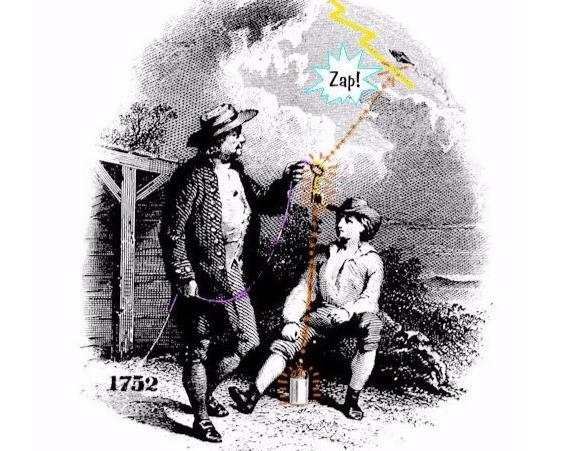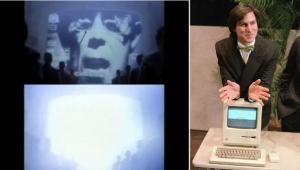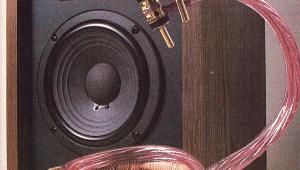An Electrifying Flashback: Franklin Flies a Kite

CodeCheck.com recounts the famous experiment Franklin conducted in June 1752:
Benjamin Franklin's wildly dangerous kite experiment has grown into an American legend. Almost everyone has heard of Franklin flying a kite with a key in an electrical storm, but few of us actually understand how the experiment works. Ben hypothesized that lightning is an electrical phenomenon, and that the electrical effect of lightning might be transferable to another object and cause an effect that could be recognized as electricity. He set out to prove it in an experiment.In 1752, on a dark June afternoon in Philadelphia, the 46 year-old Ben Franklin decided to fly a kite. With the help of his son, William, they attached his kite to a silk string, tying an iron key at the other end. Next, they tied a thin metal wire from the key and inserted the wire into a Leyden jar, a container for storing an electrical charge [and early form of capacitor]. Finally, as the sky darkened and a thunderstorm approached, they attached a silk ribbon to the key. Holding onto the kite by the silk ribbon, Ben flew the kite and once it was aloft, he retreated into a barn so that he would not get wet. The thunder storm cloud passed over Franklin's kite, whereupon the negative charges in the cloud passed onto his kite, down the wet silk string, to the key, and into the jar. Ben however, was unaffected by the negative charges because he was holding the dry silk ribbon, insulating him from the charges on the key. When he moved his free hand near the iron key, he received a shock. Why? Because the negative charges in the key were so strongly attracted to the positive charges in his body, a spark jumped from the key to his hand. Franklin's experiment successfully showed that lightning was static electricity. You can experience this same reaction when you shuffle your feet on a carpet and reach for a metal doorknob.
Franklin was actually lucky to have survived, for after this famous incident, several other would-be-scientists who performed this same kite experiment were electrocuted.[emphasis added]
Realizing that this form of electricity could be charged over a conductor and into the ground, he invented the lightning rod and conductor, providing the lightning an alternative path to the earth. Later in his life, lightning struck his own house, but his lightning rod saved it from burning.
Here’s an account of the famous experiment from Benjamin Franklin by Carl Van Doren (published in 1938). The account was written by Joseph Priestly and published 15 years after the event but read in manuscript by Franklin, “who must have given Priestley the precise, familiar details.”
As every circumstance relating to so capital a discovery (the greatest, perhaps, since the time of Sir Isaac Newton) cannot but give pleasure to all my readers, I shall endeavour to gratify them with the communication of a few particulars which I have from the best authority.
The Doctor, having published his method of verifying his hypothesis concerning the sameness of electricity with the matter of lightning, was waiting for the erection of a spire [on Christ Church] in Philadelphia to carry his views into execution; not imagining that a pointed rod of a moderate height could answer the purpose; when it occurred to him that by means of a common kite he could have better access to the regions of thunder than by any spire whatever. Preparing, therefore, a large silk handkerchief and two cross-sticks of a proper length on which to extend it, he took the opportunity of the first approaching thunderstorm to take a walk in the fields, in which there was a shed convenient for his purpose. But, dreading the ridicule which too commonly attends unsuccessful attempts in science, he communicated his intended experiment to nobody but his son" — then twenty-one, not a child as in the traditional illustrations of the scene — "who assisted him in raising the kite.
The kite being raised, a considerable time elapsed before there was any appearance of its being electrified. One very promising cloud had passed over it without any effect; when, at length, just as he was beginning to despair of his contrivance, he observed some loose threads of the hempen string to stand erect, and to avoid one another, just as if they had been suspended on a common conductor. Struck with this promising appearance, he immediately presented his knuckle to the key, and (let the reader judge of the exquisite pleasure he must have felt at that moment) the discovery was complete. He perceived a very evident electric spark. Others succeeded, even before the string was wet, so as to put the matter past all dispute, and when the rain had wet the string he collected electric fire very copiously. This happened in June 1752, a month after the electricians in France had verified the same theory, but before he heard of anything they had done.























































